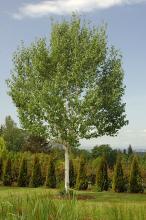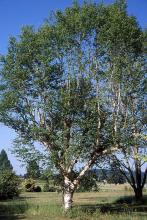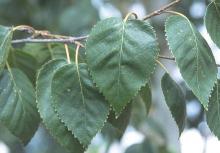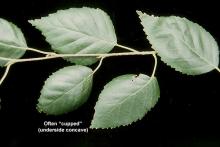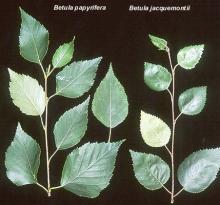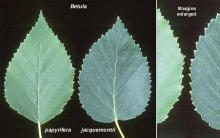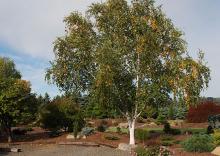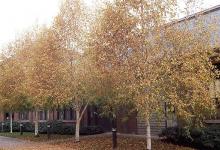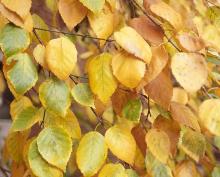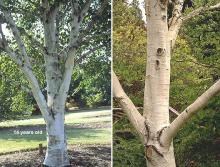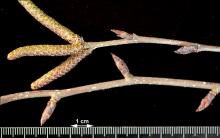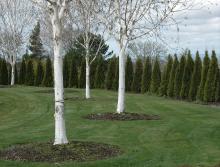Betula utilis var. jacquemontii
Common name:
Whitebarked Himalayan Birch
Pronunciation:
BET-u-la EW-ti-lis jack-MONT-e-i
Family:
Betulaceae
Genus:
Synonyms:
Betula jacquemontii
Betula utilus subsp. jacquemontii
Type:
Broadleaf
Native to (or naturalized in) Oregon:
No
- Deciduous tree, 30-50+ ft (9-15+ m), pyramidal, upward branches, white "paper" bark on trunk and often on young branches. Leaves alternate, simple, 5-7.5 cm long, rounded or slightly cuneate (wedge-shaped with straight sides) at base, margin double serrated, dark green above, glandular below, pubescent on veins, 7-9 vein pairs.
- Light to part shade, especially afternoon shade. Best in cool, moist, well-drained soil; like other birches, the roots are shallow, so it is not for high traffic areas. Listed as having "some borer resistance" in the Sunset Western Garden Book, but other authorities (e.g., Univ. Minnesota, Extension) consider it "highly susceptible" to the bronze birch borer (BBB). This pest is common east of the Cascades but was essentially unknown in western Oregon before 2003; now it is becoming an increasing problem in the Portland area and Corvallis.
- Hardy to USDA Zone 5 Native to the western Himalayas
- Taxonomy: It was described in1841 as a species separate from Betula utilis, but is now considered to be one of its varieties, Betula utilis var. jacquemontii. Technically the main differences between the variety and the species are that the variety has fewer vein pairs per leaf (7-9 pairs for the variety and 10-14 pairs for the species) and whiter bark. Although bark color can be variable, many authorities consider the bark from this variety to be the whitest found on any birch (Missouri Botanical Garden). Betula utilis is widely spread across Central Asia, from Kazakhstan through Afghanistan and the Himalayas of Pakistan, India, Nepal, Bhutan to central China. It is a very polymorphic species as regards the shape and the number of veins of the leaf, size of the male catkins and the nature of the fruiting scale, which gradually change from the Western to the Eastern limit of its distribution range. Some consider this to be an aggregate species. There is so much variation in the different parts that it merges into Betula utilis and it is hard to separate these from one another (Flora of Pakistan). Because of this, Betula utilis var. jacquemontii is sometimes considered a synonym of Betula utilils.
- jacquemontii: Betula jacquemontii was first described and named by Edouard S. Spach in 1841. Spach (1801-1879), a French botanist, named the tree to honor the French botanist and geologist Victor Jacquemont, who is best known for his travels in India. Jacquemont died of disease in Bombay in 1832 at the age of 31.
- Oregon State Univ. campus: in parking lot north of Finley residence hall

